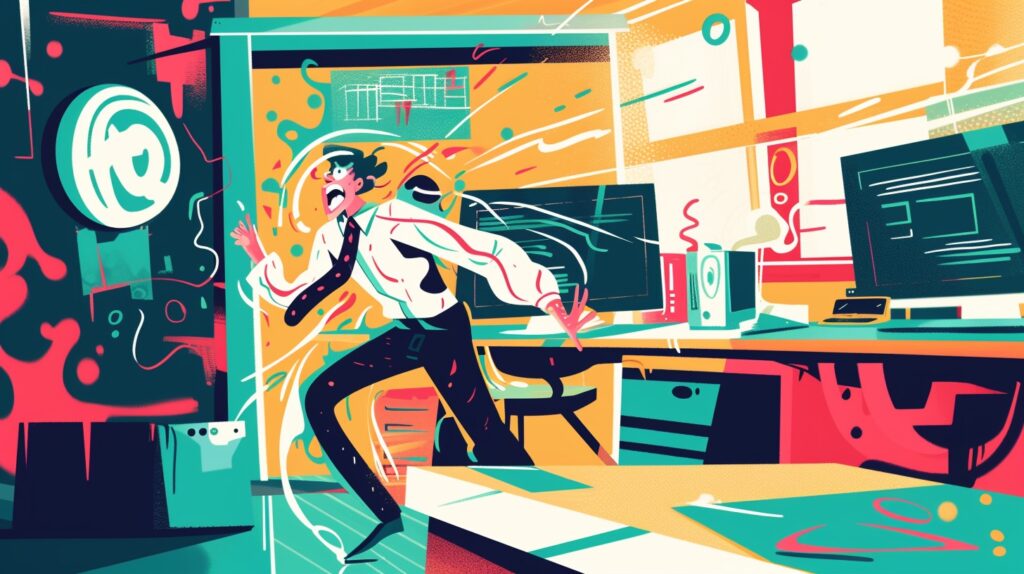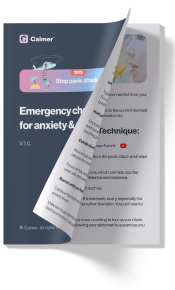Key Takeaways:
- Panic attacks at work can severely impact your productivity and mental health
- Early recognition of panic attack symptoms is essential
- Access to professional help and an understanding of workplace rights are very important
- There’s an actionable method that can help you deal with panic attacks immediately
If you’ve ever experienced a panic attack while you’re at work, you know it can be a tough and scary experience.
Having panic attacks at work is the worst – it interferes with your job performance, the ability to focus, and having a comfortable work life.
You also feel, rightfully or not, that everyone’s looking at you and you’re making a scene.

So, let’s dive deeper into panic attacks at work, how to manage them, what you can do as an employer or employee, and how they’re different from anxiety.
Here’s How Panic Attacks at Work Look Like
Panic attacks hit hard and fast, like a wave of intense fear washing over you. They can be pretty overwhelming in the moment, but the good news is they usually don’t stick around for more than a few minutes.
What is a Panic Attack? 😨 #MentalHealthAwareness | Operation Ouch
Along with the mental freak-out, panic attacks often bring some physical symptoms, like:
- Racing heart
- Dizziness
- Struggling to catch your breath
- Shaking
- Chest pain
- Nausea
- Fears of losing control or dying
They tend to sneak up out of nowhere, which can be pretty alarming for both the person going through it and anyone around who witnesses the whole thing.
I still remember my first panic attack at work. It was a regular Tuesday at the office, and I was knee-deep in deadlines, trying to wrap up a project before lunch.
Suddenly, out of nowhere, it hits me like a ton of bricks – my heart’s pounding like crazy, I can’t catch my breath, and everything feels like it’s spinning out of control.
I try to play it cool, but inside, I’m freaking out. It feels like the weight of the world is on my shoulders, and I can’t shake this overwhelming sense of fear.
My mind’s racing and I’m desperately trying to keep it together while my body’s doing its own thing.
It’s terrifying, especially when you’re surrounded by coworkers who have no idea what’s going on.
All I could think about was getting through it without making a scene, but it felt like an impossible task.
What are Panic Attacks
Panic attacks are one of the anxiety disorders, which can be triggered by stress, personal health concerns, or specific workplace issues, among other factors.
Sometimes, they happen without an obvious cause, too.
In a job setting, when you want to perform well, complete assignments on time, and manage good relationships with colleagues, it can sometimes cause panic attacks.
They can come with many physical symptoms, like your heart racing, feeling dizzy, sweating buckets, struggling to breathe, or shaking uncontrollably.
I’ve found that spotting these symptoms early on really helps me handle things better. Taking control and preventing more attacks from happening means I gotta dig deep and figure out what’s triggering these sudden fears.
And reaching out for the right help is key to getting a grip on the situation.
Managing Panic Attacks at Work
When panic attacks happen at work, it’s important to have fast ways to feel better and long-term ways to handle stress.
Having supportive coworkers and a supportive work environment can really help you get back on track and keep anxiety from messing up your day.
Get Immediate Relief
When a panic attack strikes at work, immediate actions can help mitigate its impact.
Breathing exercises are a primary tool; deep, controlled breaths can slow down the rapid heart rate and ease other physical symptoms of panic.
An effective pattern is the “4-6-8” technique:
- Inhale for 4 seconds
- Hold for 6 seconds
- Exhale for 8 seconds
This helps to shift focus from panic to the rhythm of breathing. Also, relaxation techniques like progressive muscle relaxation, in which you tense and then relax different muscle groups, can help in releasing physical tension associated with a panic attack.
Our new Calmer app can help with managing panic attacks at work. It has a dedicated Stop Panic Attack button that’s effective for calming down during a panic attack.
Apart from that, the app also offers long-term anxiety and panic attack relief, helps you decrease anxiety and stress, and can help you sleep like a child again.
Here’s How to Manage Long-Term
To manage panic attacks in the long run, it’s helpful to practice mindfulness and meditation regularly. These can lower overall stress levels, which might make panic attacks happen less often.
Medication from a doctor can also help. And regularly talking with a therapist about coping strategies can give you the tools you need to deal with triggers better. More on that later.
Here’s an example plan to put these into action:
- Spend 10 minutes meditating in the morning to start the workday calmly.
- Take breaks during the day for mindfulness or relaxation exercises.
- Have weekly therapy sessions to talk about how things are going and improve coping strategies.
How to Create a Supportive Work Environment
Employers can help workers by creating a workplace that sees and reacts to their mental health needs.
This means they should:
- Encourage open conversations about mental health
- Provide easy access to mental health resources
- Possibly set up support groups among colleagues
- Create a quiet area where employees can take a break if needed
And accessibility to professional support should include the following:
- Employee Assistance Programs (EAPs)
- Referrals to mental health professionals
- Workshops on stress management techniques
Employers should also make sure that there are clear rules in place so workers feel comfortable taking care of their mental health without worrying about judgment or punishment.
What can I, as an employee, do
But what can I, as an employee, do?
Well, I can take steps to support my own mental health and well-being. Here are some things you can do:
- Be open to talking about your mental health with your supervisor or HR if you feel comfortable. Let them know if you’re struggling and need support.
- Take advantage of any mental health resources provided by your employer, such as Employee Assistance Programs (EAPs), counseling services, or workshops on stress management.
- Practice self-care activities that help reduce stress and promote well-being, such as regular exercise, healthy eating, getting enough sleep, and engaging in hobbies or activities you enjoy.
- Reach out to friends, family, or a therapist for support if you’re experiencing difficulties. Sometimes, even just talking to someone can make a big difference.
- Don’t be afraid to set boundaries at work to prioritize your mental health. It’s okay to say no to extra tasks or overtime if it’s causing too much stress.
- Make sure to take regular breaks throughout the day to recharge and relax, even if it’s just a short walk or a few moments of deep breathing.
Panic Attacks vs. Anxiety
Panic attacks and anxiety are distinct yet related conditions, each with its own set of symptoms that can significantly affect individuals in the workplace.
| Panic attacks | Anxiety | |
| Onset | Sudden and intense | Gradual and persistent |
| Duration | Typically short-lived (a few minutes) | Can last for extended periods |
| Symptoms | Intense fear or terror, physical sensations such as rapid heartbeat, shortness of breath, sweating, trembling | Worry, nervousness, restlessness, muscle tension, difficulty concentrating |
| Triggers | Often unpredictable | Can be triggered by specific situations or stressors |
| Frequency | May occur sporadically or in clusters | Can be chronic or recurrent |
| Impact | Can be debilitating during episodes, but less frequent overall | Can affect daily functioning and quality of life on an ongoing basis |
| Treatment | Therapy, medication, relaxation techniques | Therapy, medication, lifestyle changes |
Although frequently confused, a panic attack and anxiety differ in key aspects. Panic attacks are usually abrupt and short-lived, often peaking within minutes.
Anxiety, on the other hand, can build gradually and persist over a longer period of time. Panic attacks tend to be more intense and disruptive.
In contrast, anxiety is typically less intense but can be more persistent and pervasive, affecting various aspects of life.
Both conditions fall under the umbrella of anxiety disorders and are considered common mental health issues.
Ultimately, proper recognition of panic disorder and anxiety disorder symptoms is essential for seeking appropriate care and creating a supportive work environment.
Medical and Therapeutic Interventions
When panic attacks started hitting me at work, it felt like my whole world was spinning out of control. I knew I needed help, so I reached out to a doctor and started therapy sessions.
Having a plan in place made a huge difference. And learning coping techniques and having someone to talk to about what was going on helped me feel more in control.
With time and effort, the panic attacks started happening less often, and I could finally breathe a little easier at work.
Consulting Healthcare Professionals
So, if you’re experiencing symptoms, it’s important to talk to a doctor so you can create a treatment plan.
The doctor might refer you to a mental health specialist to investigate any medical issues and provide appropriate help.
They may suggest seeing a psychiatrist or psychologist, who are experts in mental health and can offer tailored guidance and treatment.
Medication and Therapy Options
Medications
| Type | Purpose | Common medications |
| Antidepressants | Reduce symptoms | SSRIs (e.g., Prozac), SNRIs (e.g., Effexor) |
| Benzodiazepines | Short-term relief | Alprazolam (Xanax), Clonazepam (Klonopin) |
| Beta-blockers | Control physical symptoms | Propranolol (Inderal), Atenolol (Tenormin) |
Medications may provide relief from panic attacks, but they should be used as part of a broader treatment plan.
They can help manage the physiological symptoms of anxiety and are often prescribed alongside therapy.
Therapy Options
- Cognitive Behavioral Therapy (CBT) – Focuses on changing the thought patterns that trigger panic attacks.
- Psychotherapy – Involves talking with a mental health professional to understand the emotional responses to stress.
Therapies like CBT and psychotherapy can offer you long-term solutions by equipping you with coping mechanisms to handle panic attacks and anxiety.
Working with therapists, you can identify triggers and learn strategies to mitigate their influence on daily life.
Legal Rights and Workplace Accommodations
When employees experience panic attacks at work, they’re entitled to certain protections and accommodations under the law.
Understanding these rights helps in crafting a work environment conducive to managing anxiety.
Americans with Disabilities Act (ADA)
The Americans with Disabilities Act (ADA) protects people with disabilities, including those with anxiety disorders that significantly affect important parts of their lives.
If someone has a panic disorder, they might be considered disabled under the ADA. This means employers have to make reasonable changes to help them at work unless it’s really hard for the company to do so.
What is covered:
- Employment
- Access to public services
- Transportation
- Public accommodations
- Telecommunications
Eligibility:
- An individual with a disability that substantially limits one or more major life activities
- A person who has a history of such a disability
- Individuals who are perceived by others as having such a disability
Negotiating for Reasonable Accommodations
Reasonable accommodations are changes or adjustments that employers make to help people with disabilities have the same chances at work as everyone else.
These changes can be different for each person depending on what they need, but they might include:
- Adjustments to work schedules or duties
- Access to quiet spaces
- Changes in the physical workspace
- Allowing service animals or assistive devices
- Providing leave for treatment or recovery
- Telework arrangements
Employees should:
- Identify specific work-related triggers that contribute to their anxiety
- Document their needs and proposed accommodations
- Communicate with their employer formally, usually through human resources, to request accommodations
- Be prepared to provide medical documentation if requested by the employer
Lifestyle Adjustments and Self-Care
Making some changes to your lifestyle and consistently taking care of yourself can significantly decrease the frequency and severity of panic attacks at work.
These habits are designed to help you better cope with stress, enhance your overall well-being, and provide you with effective ways to quickly calm down when necessary.
Let me tell you, finding ways to cope with panic attacks at work has been a game-changer for me.
I realized that making some adjustments in my lifestyle and prioritizing self-care has made a huge difference.
From taking short breaks to practice deep breathing to scheduling regular walks during the day, these little habits have helped me manage my stress levels and reduce the frequency of panic attacks.
It’s not always easy, but by focusing on building resilience and finding what works for me, I’ve been able to feel more in control and less overwhelmed at work.
Incorporating Physical Activity and Exercise
It’s shown that doing physical exercises often helps to decrease stress and make mental health better. People are advised to try the following:
- Moderate-Intensity Exercise such as brisk walking or cycling for at least 30 minutes most days.
- Strength Training involving major muscle groups on two or more days a week.
When panic starts to emerge at work, quick exercises like stretching or a brief walk can act as grounding techniques, helping to distract and calm the mind.
Building a Support System
A robust social support network is essential for emotional well-being. You should:
- Communicate with trusted co-workers about their condition, gaining allies in the workplace.
- Join Support Groups where others share similar experiences, providing reassurance and understanding.
Leveraging social support enables you to share coping strategies and feel less isolated in your experiences.
Self-Care and Mindfulness Practices
Mindfulness and self-care practices are vital tools for managing anxiety and stress. They include:
- Deep Breathing Exercises: Taking slow, deep breaths can help control the panic and bring one’s focus back to the present.
- Structured Relaxation: Engaging in yoga or meditation can lessen anxiety levels and improve focus.
Creating a regular practice of mindfulness ensures you have a personal toolkit to deploy when symptoms arise.
And if you want to have a helpful toolkit for anxiety and panic attacks at your fingertips at all times, download our new Calmer app that offers cutting-edge breathing tools, daily journeys and tasks, actionable and bite-sized school, emergency SOS section, and much more.
Frequently Asked Questions
What strategies can I use to manage panic attacks while on the job?
Consider practicing deep breathing exercises and mindfulness techniques to help ease the onset of a panic attack.
Having access to a designated quiet space where you can retreat during an attack can also be beneficial.
How should I approach a conversation with my boss about panic attacks in the workplace?
When discussing panic attacks with your supervisor, it’s best to be transparent. Explain your condition calmly and professionally.
You may also want to suggest accommodations that could help you manage the condition while at work.
Can I call in sick if I experience a panic attack at work?
Yes, experiencing a panic attack can be a valid reason to call in sick. Be sure to review your company’s sick leave policy and provide any necessary documentation, such as a note from a healthcare provider, if required by your workplace.
What are the main differences between a panic attack and an anxiety attack?
A panic attack usually comes on suddenly and intensely, triggering severe physical reactions without an obvious cause.
On the other hand, an anxiety attack often develops gradually in response to a perceived stressor and is generally less intense.
How can I deal with the embarrassment of having a panic attack at work?
Seek support from trusted colleagues or HR personnel. Remember, panic attacks are a common health issue, and it’s okay to ask for help.
What are the potential consequences of having recurrent panic attacks at work, including the risk of job termination?
Recurrent panic attacks could impact job performance, leading to discussions with management about job fit or potential modifications.
In severe cases where performance and safety are compromised, job termination might be a possibility. However, many employers will try to find suitable solutions before considering termination.




